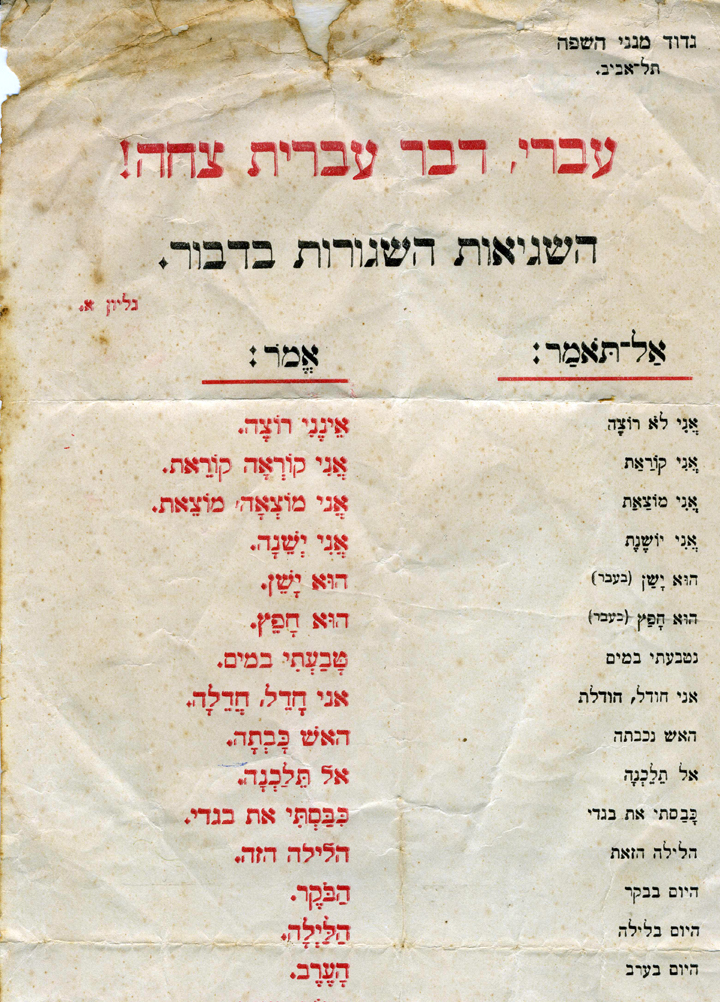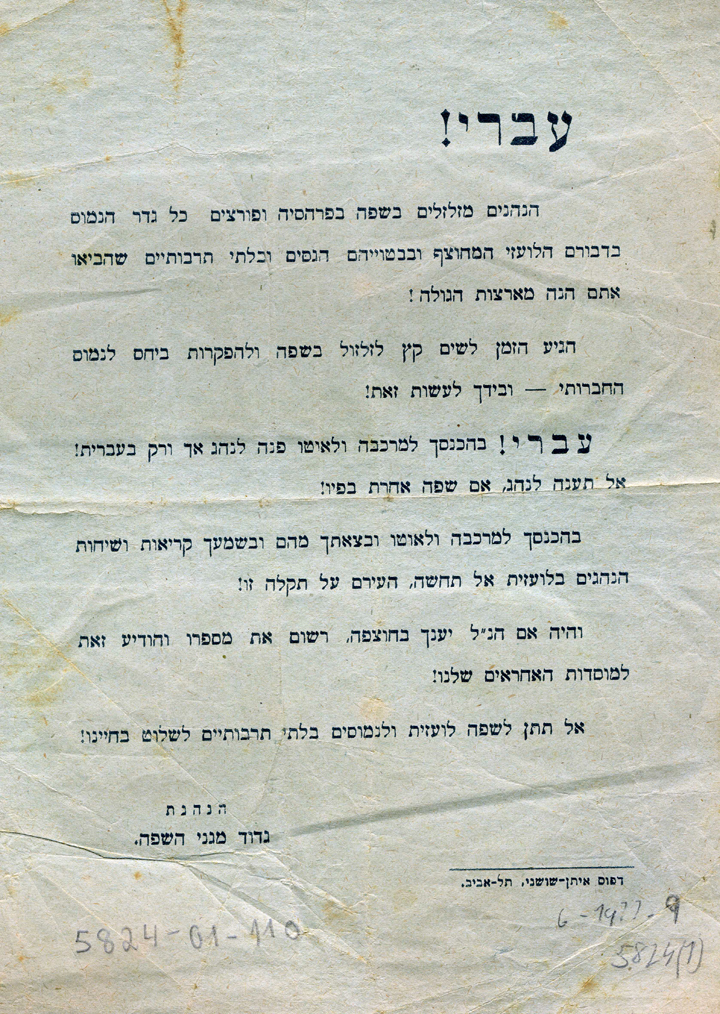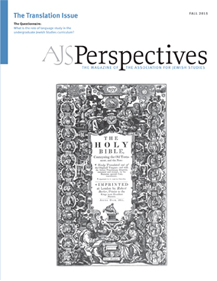
Taken on its face, this episode seems to exemplify the ways in which pro-Hebrew activism in interwar Palestine helped move the Yishuv from the multilingual situation characteristic of the Jewish Diaspora to the coalescence of a unified national ethos around Hebrew. Looked at more closely, however, instances of activism like this one contain within them clues about a more complex linguistic reality, one less detached than it might seem from political and cultural patterns usually associated with the Diaspora, that is, the presumed opposite of the new society being created by Jews in Palestine.

We can observe the dynamics of the Yishuv's multilingualism in archival documents surrounding the very instances of activism that appear on the surface to negate its possibility. Let's take for instance the episode with which we began. On November 18, 1927, Menachem Ussishkin, one of the most outspoken opponents of the Yiddish chair and an advisor to the militant Brigade of the Defenders of the Hebrew Language, wrote a letter to his colleague, the pro-Hebrew scholar Josef Klausner. In it he included a copy of a telegram he intended to send to Chancellor Magnes to warn him against the proposed Yiddish chair. The telegram read, in English, as follows (sic): "As friend University and yourself beg you relinquish Yiddish chair whatever the conditions. Huge outburst being organised severer than Hilfsverein. Whoever triumphs ruin certain. Withdraw prior kingdling battle." In what followed in the accompanying letter, Ussishkin appended a Russian proverb: Bog ne vydast, svin'ya ne s'yest (God willing, everything will be alright, literally: God will not betray, pigs will not gobble it up).
No less than five different languages are involved or invoked in this exchange: the communication between Ussishkin and Klausner is in Hebrew; the controversy at hand pertains to Yiddish; the telegram, written in English, references the Hilfsverein der deutschen Juden, the organization that proposed German-language teaching at the Haifa technical university in 1913, provoking a public outcry; and Ussishkin's proverb is in Russian.
What do we make of all this? To begin with, it is significant than the language of the exchange, like most professional exchanges between committed Zionists in Palestine at this time, is in Hebrew. As a result of this fact, Zionist archives seem often to reflect a society that had fully transitioned to Hebrew as a language of both administration and daily usage. The embedded content of the exchange, however, betrays both lingering anxieties about other languages as well as structural limitations on the reach of Hebrew.
If the telegram to Chancellor Magnes uses militant language, the private correspondence between the two pro-Hebrew activists suggests they were aware that this might not be a battle easily won. Moreover, they must have known that the model of Hebrew success they invoked to threaten Magnes, the Hilfsverein controversy, had not yielded uncomplicated victory. Yes, in 1914, the Hilfsverein der deutschen Juden, proposing a technical university in Haifa that that would eventually become the Technion, yielded to demands that all subjects, including scientific ones, be taught in Hebrew. But by the late 1920s, German was still the dominant spoken language of the Hebrew University. Professors did not always embrace Hebrew: complaints surfaced that the corridors of the Hebrew University were indistinguishable from the university halls of Charlottenburg. Moreover, scholars continued producing academic work in German and, over time, in English, understanding that these languages were the coin of the global marketplace of ideas. Behind confident pro-Hebrew demands lay a more anxious recognition that Hebrew exclusivity, though symbolic of a nation coming into being, could not sever the global bonds that would continue to influence the language choices of Jews in Palestine: not only the academic elite, but also businessmen looking for contacts abroad, clerks facilitating importexport operations, and immigrants nostalgic for the high culture of their home countries.
Some of those contacts would invariably be in English. Bureaucratic contacts with British offices compelled some middle-class Jews in Palestine to attempt to burnish their English skills to get a decent job; even militantly pro-Hebrew institutions such as the Tel Aviv Municipality had Englishspeaking clerks. Some of the English-based correspondence was between Zionists: here the English-speaking Judah Magnes was (ironically) in charge of determining whether a Yiddish chair would be established at the university or whether Hebrew would (ostensibly anyway) reign supreme. That Ussishkin and Klausner deemed it necessary to voice their pro-Hebrew linguistic agenda in broken English (a product of British telegraph policies) reminds us that above the fractious interplay between Hebrew and Yiddish loomed global language pressures that neither the Yishuv nor the State of Israel could escape.
Moreover, the most intimate part of the exchange between Ussishkin and Klausner, the hope that things would turn out all right, was expressed in Russian. Russian was not the mother tongue of either man, nor the language of local power, but rather the language of their former host culture: the Russian Empire. Russian was the language of an effort (by non-Jews and some Jews) to assimilate Jews into a new modern high culture. It was also the language of a local non-Jewish culture rooted in Russian Orthodoxy. This particular expression (about God and pigs) is both explicitly Christian and suggestively treyf. But it was part of the multivalent world of language that intellectuals like Ussishkin and Klausner could draw upon as they planned their attack strategy against Yiddish and in favor of Hebrew.
The telegram encapsulates an Ashkenazic Zionist story characterized by squabbling over the merits of Hebrew, German, Yiddish, and Russian and ultimately finding places for all of them in the Hebrew-dominant society of the Yishuv. Behind this story, however, was a local controversy about the local Arabic-speaking context. As it happens, both Klausner and Ussishkin, five years earlier, had sat on a committee to discuss founding a School of Oriental Studies at the Hebrew University (it would eventually be founded in 1927). Klausner had suggested that "The Hebrew language demands knowledge of the Semitic languages, the development of the Oriental spirit, and therefore one of the first things needs to be the opening of the Department of Oriental Studies . . ." Debates about the purpose of Arabic would occupy many educators, including those who rejected teaching European foreign languages in the schools. Was Arabic necessary for students because of its similarity to Hebrew? Was it a means of promoting good relations with Palestinian Arabs? Was it a way to negotiate an inherently violent encounter? An exchange about one subset of languages, complex enough on its own, might remind us of the even broader field of language questions with which this society contended.
Klausner and Ussishkin's leadership of a movement to block the creation of a Yiddish chair at the Hebrew University, sensational as it was, was thus only the tip of an iceberg of multilingual pressures, conflicts, and challenges; the majority of which lay beneath the surface of official pro-Hebrew rhetoric. But dig deeper, into the correspondence, institutional archives, and memoirs, and a more complex picture begins to emerge. A society claiming and striving to break from its past was still engaged in a set of diverse language challenges and intercultural connections that had long been—and would continue to be—characteristic of the Jewish people.

